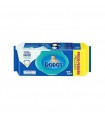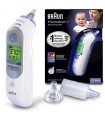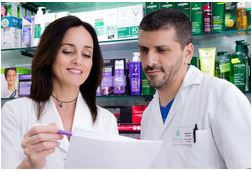ACTION AND DESCRIPTION
A bottle with a nipple suitable for the baby's age, size, physiological characteristics and preferences should be chosen, as this will depend on the degree of acceptance of the bottle, the quality of the suction and the correct maxillary and palate development.- It is necessary to ensure that the flow of water, milk or food is adequate. In no case is it advisable to increase the size of the hole, since this suppresses the feeling of tiredness (necessary for the satiety of the infant) and promotes the development of bad digestions, with vomiting and abdominal pains.- Special care must be taken with the state of conservation and hygiene, sterilizing them periodically and renewing them when necessary.- The bottle should be prepared by adjusting the milk and water ratios to the doses prescribed by the pediatrician or as specified by the manufacturer. Overly concentrated bottles can cause symptoms of dehydration and digestion problems, while over-diluted bottles do not feed properly.- When the child does not completely exhaust the contents of the bottle, the excess should be thrown away. You should also not overheat the milk or leave it at room temperature for more than a few minutes.- After each intake, the bottle must be washed immediately as milk is an excellent culture medium for bacteria.
CONSERVATION AND EXPIRATION
The term "cleaning" of children's crockery does not imply the same meaning for all people, so it is advisable to make a number of recommendations in order to achieve the same routine for all people who care for the infant.
The cleaning process should be a habit, a daily routine that must always be performed in the same way, so that regardless of the person in charge of the cleaning, the result is optimal and ensures the asepsis of the material.
Cleaning child dishes is essential, because the infant's body has weak antigenic capacity, so an infection, such as gastroenteritis, can have very serious consequences.
All material that will be in contact with the neonate, must have optimal hygienic conditions.- Before preparing the bottle, wash your hands thoroughly, with soap and dry them with a clean towel.- Any microorganisms should be removed by boiling or using the usual sterilizers.
While the baby is fed by his mother, hygiene monitoring is reduced to the few items that can get into the mouth, which are the fingers and pacifier, but the move to artificial breastfeeding, especially if it is earlier than 4 months, implies, not only that the contribution of the immune defenses contained in the mother's milk is lost , but, above all, that a risk factor is incorporated, because a rest of hot milk becomes a bacterial culture medium.
The routine should begin when you finish a shot: "After each shot, you have to wash the bottle with plenty of hot water, soap and a brush."
- A number of used and washed elements can be accumulated (the number depends on the type of technique chosen), for sterilization, usually once a day, and are left to dry.- On the market there are different types of sterilizers, based on various physical or chemical procedures, to eradicate the microbial load.In case of thermo-resistant materials there are pills or solutions that act in cold.There is the option of sterilizers that use the germicidal effect of boiling water vapour or that originated from electrical appliances of various kinds.a) Cold sterilizationChemical process that uses the oxidizing action of hypochlorous acid, in the form of solution or tabletsIt allows to sterilize the items only by inserting them (bottles, nipples, threads, pacifiers, bites or toys), in a bucket with water and a chemical solution (in the form of solution or tablets).Sterilization time varies, and ranges from average to one hour.The solution should be renewed every 24 hours to prevent possible infections.Sterilized elements should be clarified.b) Heat sterilizationBoiling water destroys pathogenic microorganisms.Sterilization occurs through water vapour and lasts from 10 to 20 minutes.The bottle is previously filled with water up to two-thirds of its volume, placing it face down so that the hot steam passes more easily.
PRECAUTIONS AND WARNINGS
Bottles must be provided with a volume scale in milliliters.
The accuracy of the measurements indicated in a bottle is very important: since, if the proportion of water and milk powder is not maintained, too high a load may be caused on the infant's kidney, or too much water may be being given with respect to the milk that actually contains a bottle.This also happens if the poorly flushed powder is added: REMEMBER "Use the measure included in the dust pack or bottle, well flushed and do not fill it".
Risks of bottle feeding:
1. Aerophagy: During shooting, the bottle should be kept well inclined to prevent the baby from ingesting excess air that could cause severe cramping pain.2. Burns: Sometimes, especially if the microwave is used, the bottle body does not heat up, but the contents may be close to boiling. The temperature of milk or porridge should be checked before administered to the newborn to avoid burning.3. Affective problems: The baby should never be deprived of the positive affective aspects of breastfeeding. Therefore, it is important that while the bottle is being given, the affective relationship of the parents with the newborn is enhanced with words, kisses or caresses.4. Material detachment: In the face of the high temperatures to which the bottle is subjected, the detachment of materials, which could clog the airways or the migration of toxic products, may occur. The choice of quality products guarantees safety in this regard.5. Drowning from excessive food flow.
Always use this product under adult supervision.
Continuous and prolonged fluid suction can cause cavities.Inspect the nipple carefully before each use and pull it in all directions. Discard it at the first sign of deterioration or fragility.Keep out of reach of children all components that are not in use.Do not leave the nipple in direct contact with sunlight or other heat sources, nor leave it longer than recommended submerged in sterilizing solution. All of this can damage the nipple.Never use nipples as a pacifier.Always check the temperature of the food before taking.




































